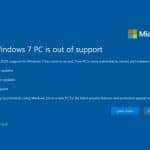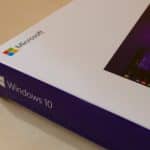Windows 7 and EOL systems and their impact on the IT workload

As of January 14, 2020, Microsoft has discontinued Windows 7 support as planned for the operating system's End of Life (EOL). To some organizations, this operating system (OS) might seem like a distant memory. However, nearly 30 percent of the world’s computers -- or more than 400 million -- still run Windows 7 and are only now contemplating migration to Windows 10. Millions of users will be depending on an unsupported OS for some time after its retirement and IT teams will still be responsible for maintaining these systems.
While Microsoft will not be globally pushing out any more security patches for Windows 7 after Jan 14th, customers can pay for a security update service which will deliver patches until 2023. Failure to sign-up for and implement these patches will mean operating an OS that is vulnerable to malicious actors. IT teams will need to continue updating and patching Windows 7 as long as their company is using it -- even if they are in the process of migrating to Windows 10.
Switching from Windows 7 to Ubuntu Linux is very easy, so why is Canonical making it seem so hard?

I am a huge proponent of using Linux-based desktop operating systems, and I try to convert people from Windows whenever it makes sense. Why do I do this? Well, Linux distributions, believe it or not, are often easier to use than Microsoft's operating system. With so many people living in the web browser these days, a Linux installation with Google Chrome is largely all an average user needs. More advanced users can install excellent free software such as LibreOffice or GIMP -- if needed. Not to mention, it can be argued that Linux is more secure than Windows. Overall, switching to Linux is a huge win for many.
Even installing a Linux distro is easy these days. Long gone are the days where the installation required a degree in computer science (except for Arch, maybe). The current Ubuntu installer, for instance, is more straightforward than the one found on Windows 10! So why in the hell is Canonical, the maker of Ubuntu, making it seem so damn hard? You see, the company has put out an installation guide that will make a person curious about switching to Ubuntu to instead run for the hills.
Most antivirus companies will continue to support Windows 7

Microsoft may have dropped Windows 7 like a hot stone, but that doesn't mean everyone is. Recognizing the fact that large numbers of people are going to continue using the aged operating system, most antivirus firms are going to continue to offer support.
Support from the likes of AVG, Avira, Kaspersky and Trend Micro for at least two years is great news for those concerned about the security of sticking with Windows 7. Of course, this doesn't mean that the operating system is entirely safe to use now that it has reached end of life, but with the right software installed, hangers-on can secure their systems somewhat.
Official how to switch from Windows 7 to Ubuntu Linux tutorial now available

If you are still using Windows 7 on your computer, you are making a huge mistake. Running an unsupported operating system is pure foolishness -- there will be countless exploits in the future for which you simply won't receive patches. In other words, your data and overall online safety is now at major risk. If you insist on sticking with Microsoft's operating system, you might as well upgrade to Windows 10 -- either by installing the operating system on your current computer or buying a new PC with the OS pre-loaded.
Understandably, many people are scared of Windows 10 -- Microsoft's data collection through extreme telemetry can make it feel like your own computer is spying on you. In that case, a Linux-based operating system should be considered. Today, Canonical releases an official guide for those thinking of switching to Ubuntu from Windows 7. Not only does the guide address potential hardware incompatibilities, but it provides a handy list of popular Windows software and its comparable Linux alternatives.
Microsoft says it will release black desktop bug fix to all Windows 7 users for free

Some Windows 7 users who installed the KB4534310 update found that their desktops turned black. With the operating system having now reached end of life, the company said that it would only make a fix available to organizations paying for Windows 7 Extended Security Updates (ESU).
But Microsoft has changed its mind. It now says that it will make a patch available for all Windows 7 users, addressing the bug introduced by the last ever freely available Windows 7 update.
Your Windows 7 desktop has turned black? Microsoft has a fix on the way... and workarounds in the meantime [Updated]

Windows 7 is dead: you know this. There are no more Windows 7 updates for most people: you know this. And some believe Windows 7 should be made open source: yeah, right
Whatever the status of Windows 7, the fact of the matter is that there are plenty of people still using it, and the last update (KB4534310) caused a strange problem for some users, turning their desktops black. Microsoft has now acknowledged the issue, but says that it will only fix the bug for those who are willing to pay.
Should Microsoft make Windows 7 open source? The Free Software Foundation thinks so!

Windows 7 is dead to Microsoft -- unless, of course, you're willing to pay. It's now ten days since the operating system reached end of life, but many people, for various reasons, are choosing to stick with it rather than upgrading to Windows 10.
This means missing out on security updates, but the Free Software Foundation (FSF) thinks it has a solution. It suggests that Microsoft 'upcycles' Windows 7 and makes the operating system open source so that the community can "study and improve" it.
Microsoft confirms that most Windows 7 users won't get a critical Internet Explorer security patch

Internet Explorer may be a relic from the past, but it's still out there and used by surprising numbers of people. Not all versions of it are supported by Microsoft anymore, so when a critical bug was discovered in the Windows 7, 8.x, 10, Windows Server 2008 and 2012 versions of the browser, there were questions about who was going to be protected.
The bug was revealed just days after support ended for Windows 7, and it wasn't clear whether Microsoft would stick to its guns and leave those people still using this operating system out in the cold and unprotected. The company has now confirmed what's going to happen.
You can still get Windows 7 updates without paying a penny to Microsoft

It can hardly have escaped your attention that Windows 7 has now reached end of life. For companies and enterprise customers unwilling to pay for Extended Security Updates, this means there will be no more updates. The average home user who has decided to stick with Windows 7 has been completely abandoned by Microsoft, leaving them with an operating system that could be found to contain an endless number of security vulnerabilities.
But, actually, there is another option for home users, and it does not involve paying any money to Microsoft. We're talking micropatches. Specifically, we're talking about micropatches from 0patch. We've covered the work of this company in the past, including its recent fix for the Internet Explorer vulnerability.
0patch releases micropatch for Internet Explorer vulnerability -- including for Windows 7
At the end of last week, a serious vulnerability was discovered in Internet Explorer, affecting all versions of Windows. Not only is the bug (CVE-2020-0674) being actively exploited, but for Windows 7 users the vulnerability was exposed right after their operating system reached the end of its life.
Even for users of newer versions of Windows, and despite the severity of the security flaw, Microsoft said it would not be releasing a patch until February. Stepping in to plug the gap comes 0patch with a free micropatch for all versions of Windows affected by the vulnerability.
Windows 7 desktops are turning black

Anyone who has decided to stick with Windows 7 now that the operating system has reached end of support has probably seen the full-screen warning advising them that it's time to upgrade to Windows 10. But while this warning was known about in advance, some Windows 7 hold-outs are now reporting something peculiar post January 14 -- a black desktop.
On the last day of support for Windows 7 Microsoft issued one final update, and it seems that this update has been causing problems with desktop wallpapers.
Microsoft sends mixed messages by releasing Chromium-based Edge browser for unsupported Windows 7

Windows 7 is officially dead now. Believe it or not, Microsoft has actually done a great job of alerting users of the now-unsupported operating system that it is time to upgrade. Whether or not users take the advice and move to Windows 10 is another story. The company is even displaying full-screen warnings that Windows 7 is unsupported -- a move I applaud. Is it annoying? Yes, but necessary. Staying on Windows 7 is foolish.
But now, Microsoft has effectively destroyed all of the positive work it had done with communicating the death of Windows 7. You see, today, the company releases the all-new Chromium-based Edge. This browser is available for Windows 10 and macOS as you'd expect, but shockingly, it is available for yet another operating system -- Windows 7. Wait, what?!
Microsoft turns the screws on Windows 7 users with full-screen upgrade warnings

It can hardly have escaped your attention that yesterday was the day Microsoft stopped supporting Windows 7.
To make sure anyone who was unaware is alerted to the fact that no more security updates will be available, full-screen warnings are now being displayed. Microsoft had previously advised Windows 7 users that this message would appear, and as of today the company is making good on its promise.
NSA discovers a serious flaw in Windows 10

The US National Security Agency (NSA) has discovered a major flaw in Windows 10 and Windows Server 2016 that could potentially expose users to "significant breaches or surveillance", according to the Washington Post.
In the past, the NSA might have simply weaponized the vulnerability, as it did by creating hacking tool EternalBlue, but this time around the organization instead chose to report the flaw to Microsoft, and a fix is expected to be issued as part of today’s Patch Tuesday updates.
Today is the day Windows 7 dies, but you can still upgrade to Windows 10 for free

After a decade of service, Windows 7 is, effectively no more. Microsoft no longer supports the operating system for those unwilling to pay for extended service leaving millions of machines vulnerable. Now that Windows 7 is dead, Microsoft may prefer you to invest in a new Surface, but it is cheaper -- much cheaper -- to upgrade to Windows 10.
Microsoft initially made quite a fuss about that fact that while it was possible to upgrade to Windows 10 for free, it was a time-limited offer. Many people rushed to upgrade because they felt the deadline was hanging over them like the sword of Damocles… but it seems that the deadline was not as pressing as Microsoft made out. You might be surprised to learn that more than five years after the launch of Windows 10, it is still possible to upgrade for free. Here's what you need to know.
Recent Headlines
Most Commented Stories
Windows 12.1 is everything Windows 11 should be -- and the Microsoft operating system we need!
Apple Intelligence will launch in beta and that’s unacceptable for a trillion-dollar company
© 1998-2024 BetaNews, Inc. All Rights Reserved. Privacy Policy - Cookie Policy.